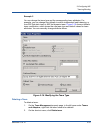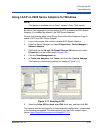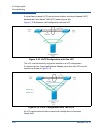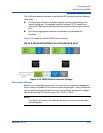
2–Configuring NIC
NIC Partitioning (NPAR)
2-40 SN0054671-00 B
NPAR Configuration
This section defines NPAR configuration, options, and management tools you can
use to set up NPAR on the 8200 and 3200 Series Adapters.
In addition to defining NPAR, this section describes:
“NIC Partitioning Options” on page 2-40
“Personality Changes” on page 2-41
“Quality of Service” on page 2-42
“eSwitch” on page 2-43
“Configuration Management Tools” on page 2-44
NIC Partitioning Options
The NPAR feature in 8200 and 3200 Series Adapters provides the ability to create
multiple PCIe physical functions for each physical 10 GbE port on the adapter.
Each PCIe function appears as an independent interface to the host operating
system or hypervisor.
When the 8200 and 3200 Series Adapters are configured as Ethernet-only, each
adapter contains eight Ethernet functions.
By default, NPAR functionality is disabled on the adapters, having only two
Ethernet functions enabled. Depending on the feature personality mapping
supported on the adapter, you can enable additional Ethernet or storage
functions.
The PCI function number assignment is as follows:
Functions 0 and 1 are always NIC, function 0 for port 0 and function 1 for
port 1; any of the other functions can be individually enabled or disabled.
NIC, iSCSI, and FCoE have fixed function numbers.
Functions 2 and 3 can only be NIC personalities.
Functions 4 and 5 can be iSCSI or NIC personalities.
Functions 6 and 7 can be FCoE or NIC personalities.
You can configure only one iSCSI and one FCoE personality for each
physical port.
The 8200 and 3200 Series Adapters support a maximum of 64 Layer-2 MAC
address filters across all partitions, which limits the number of virtual network
adapters that can be created on a partitioned NIC. The NIC driver evenly
distributes the number of filters across all NIC partitions.
For example, if the NIC adapter has four NIC partitions, two NIC partitions per
physical port, then each NIC partition gets 16 filters (64/4 = 16). In this case, do
not create more than 16 virtual network adapters on any NIC function that is
configured to be used by a Hyper-V network virtualization stack.


















